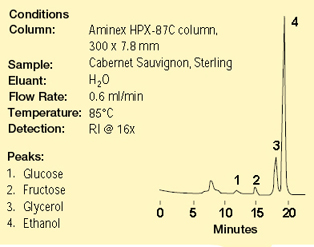The analysis of wine fermentation products provides a wealth of information. Specifically, analysis of ethanol and glycerol provides an indication of the progress of fermentation, and since the amount of glycerol correlates with the smoothness of the wine it is also used to help determine and predict the quality of the final wine product.
Related Topics: Antibody Purification, Polyhistidine-Tagged Recombinant Protein Purification and On-Column Refolding, Chromatography in Food Production, Disease Diagnosis Using Chromatography, and Protein Purification and Isolation.
Page Contents
Chromatographic analysis of wine fermentation products using an Aminex® HPX-87C column and a RI detector provide a fast and accurate technique for quantitatively determining ethanol and glycerol. The RI detector detects fermenting carbohydrates, glycerol and alcohol that may be present in the wine. As an example, the figure below presents a typical sugar profile for a cabernet sauvignon wine, obtained with the Aminex HPX-87C column and a RI detector.

Sugar and alcohol analysis in wine on the Aminex HPX-87C column.
